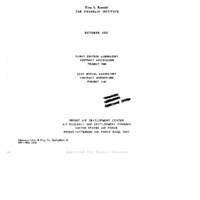-
Title
-
Dynamic Response Of Human Operators
-
Date
-
1957
-
Index Abstract
-
Coming Soon
-
Photo Quality
-
Complete
-
Report Number
-
WADC TR 56-524
-
Creator
-
McRuer, Duane T.
-
Krendel, Ezra
-
Corporate Author
-
Control Specialists, Inc. and Laboratories For Research And Development, Franklin Institute
-
Laboratory
-
Flight Control Laboratory
-
Extent
-
266
-
PB Number
-
PB131823
-
NTRL Accession Number
-
AD110693
-
Identifier
-
AD0110693
-
Access Rights
-
OTS
-
Distribution Classification
-
1
-
Contract
-
AF 33(616)-3080
-
DoD Project
-
1365
-
DoD Task
-
13554
-
DTIC Record Exists
-
No
-
Distribution Change Authority Correspondence
-
USAFAMRL ltr
-
Date Modified
-
Scanned by request 10/24/2007 submitted by University of Tokyo (University - International)
-
Abstract
-
This report presents the results of a concerted effort to arrive at a suitable mathematical description of human operator dynamic response. The investigation has been primarily concerned with operations in which continuous closed-lopp control is exerted in a visual input, manual output tracking situation subjected to excitation by random appearing forcing functions. The basic input to the study was a relatively large body of data on human response characteristics, some available from earlier investigators and some from concurrent experiments. All of the data available, published or unpublished, were considered in arriving at the various descriptions of interest. Generally speaking the best-designed and instrumented experiments yield data in two parts. The first is that portion of the operator output response linearly coherent with his input and generally taking a describing function form which involves amplitude and phase information as a function of frequency. The second is that portion of the operator's response not linearly coherent with his input, the "remnant". This latter part, by its basic nature must be described by statistical quantities. A portion of the report is devoted to an exposition of the mathematical basis for the models derived and measurements taken, and possible sources of the remnant. All of the quasi-linear describing function data obtained, including some presented for the first time, were curve-fitted to yield simple mathematical expressions which are descriptive of the linear portion of the operator's response for varying machine dynamics and forcing functions. The available remnant data statistics are correlated with task difficulty and an attempt is made to "explain" the remnant in terms of three logically distinct sources, each resulting in equivalent operator output power. On the basis of these correlations and explanations it appears possible to define mathematically, within limits, the dynamic behavior of the operator for the class of tasks considered. The definition becomes increasingly questionable as the demands of the tasks increase. The simple tasks can further be used to define a "preferred" operator describing function form so that definitive criteria for the improvement of a man-controlled machine is established.
-
Report Availability
-
Full text available
-
Date Issued
-
1957-10
-
Provenance
-
AFRL/VACA
-
Type
-
report
-
Format
-
1 online resource
 WADCTR56-524.pdf
WADCTR56-524.pdf